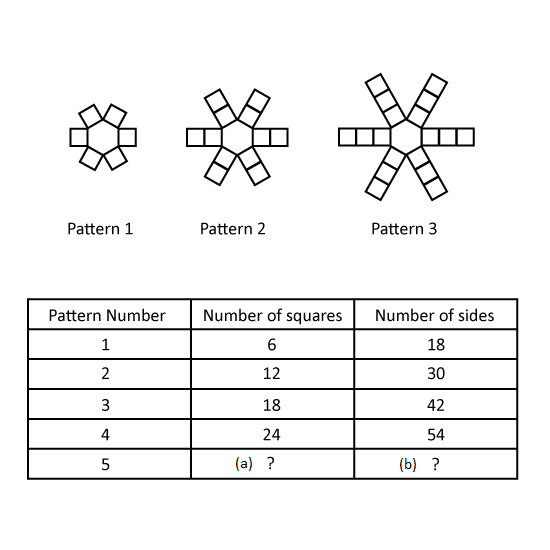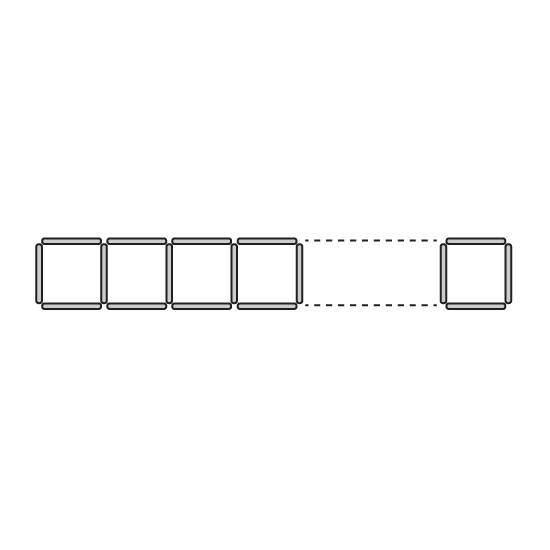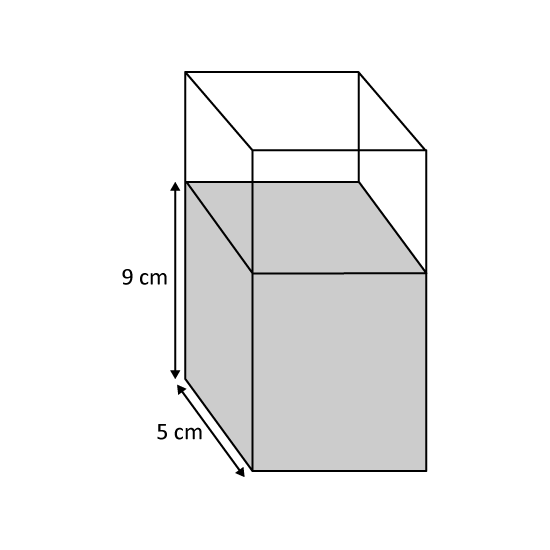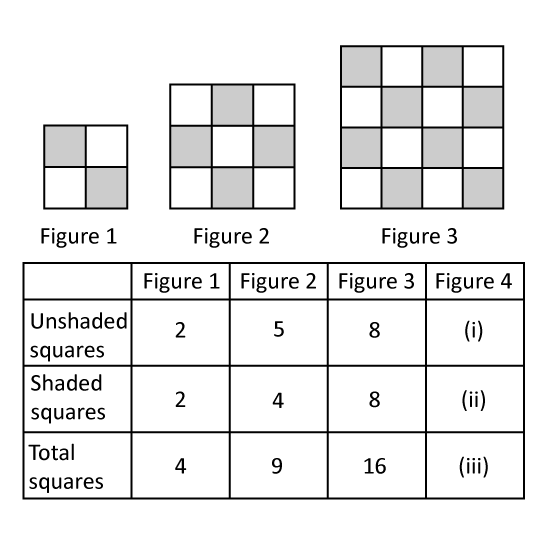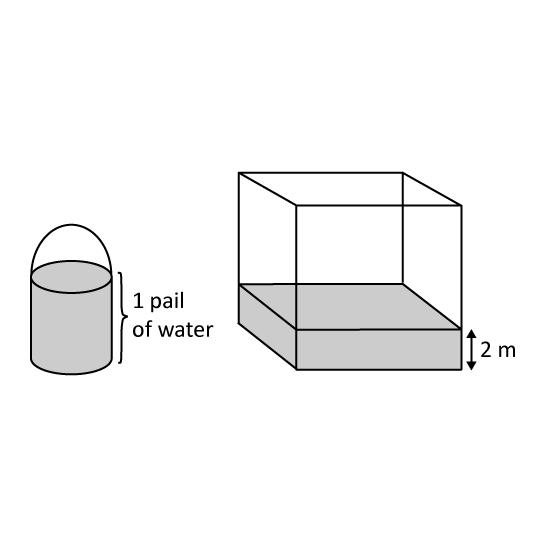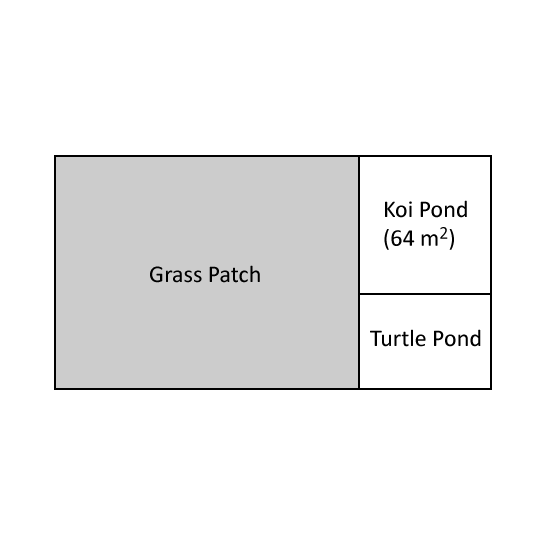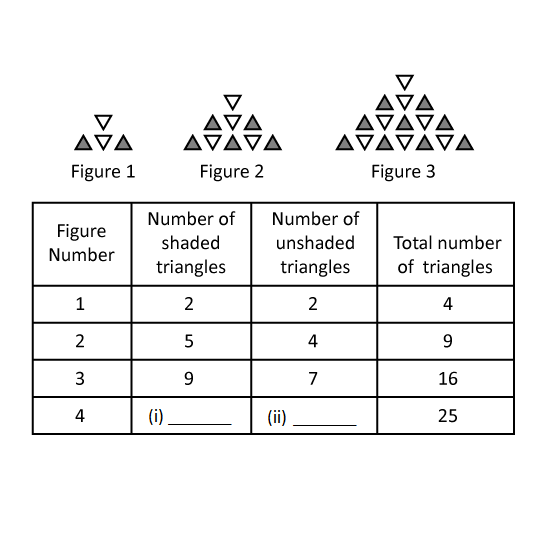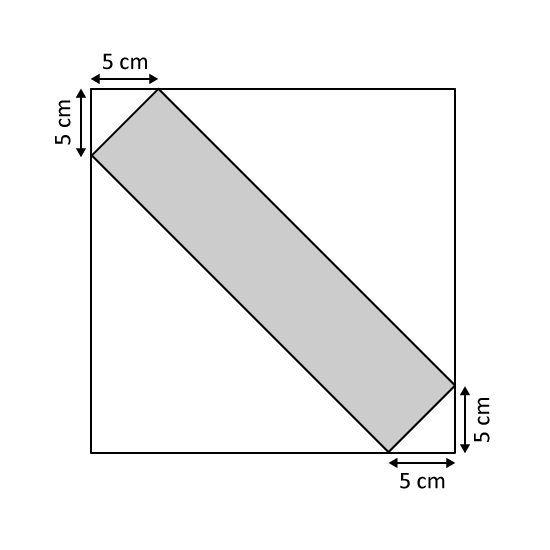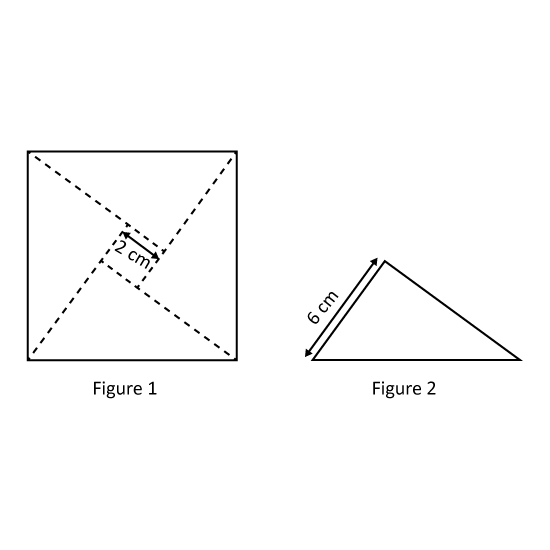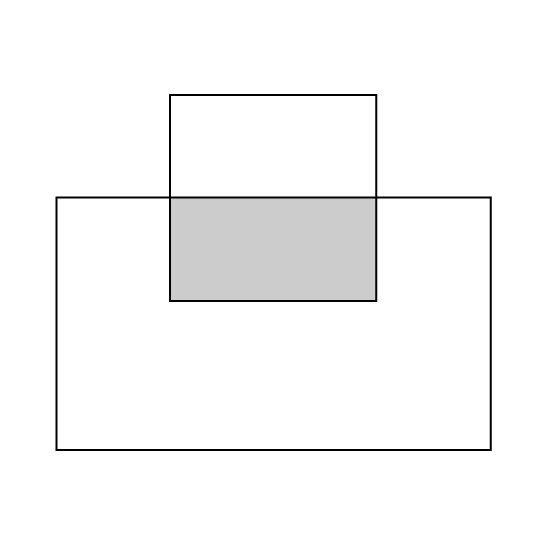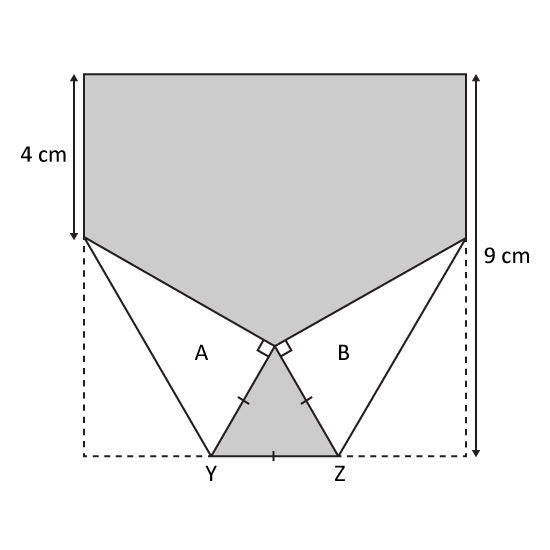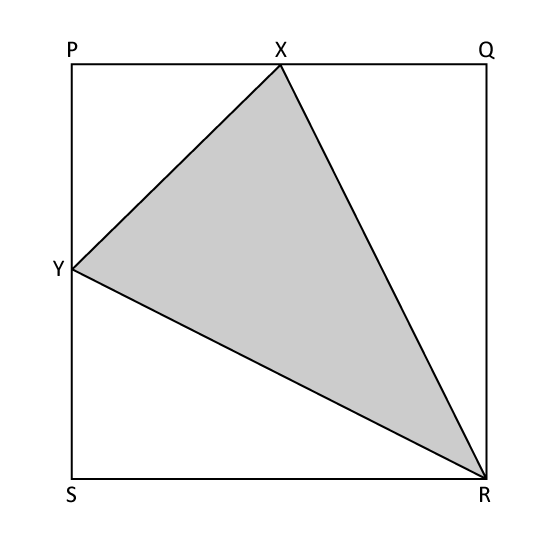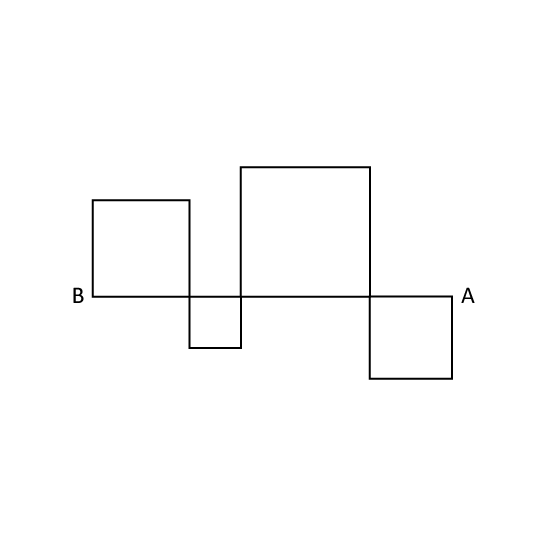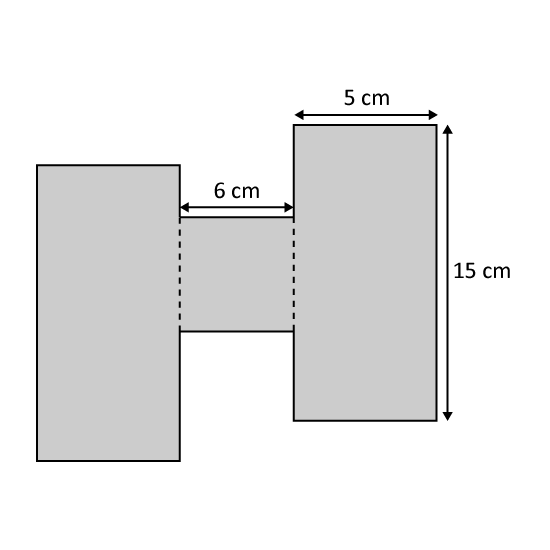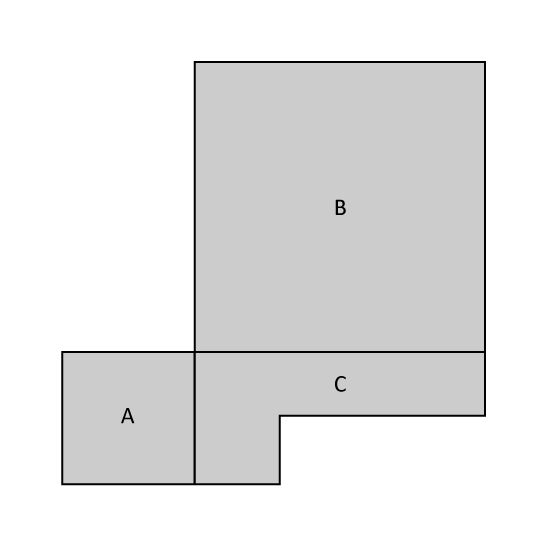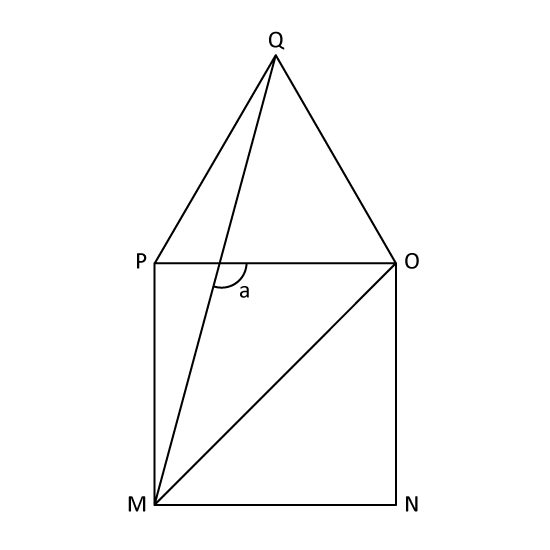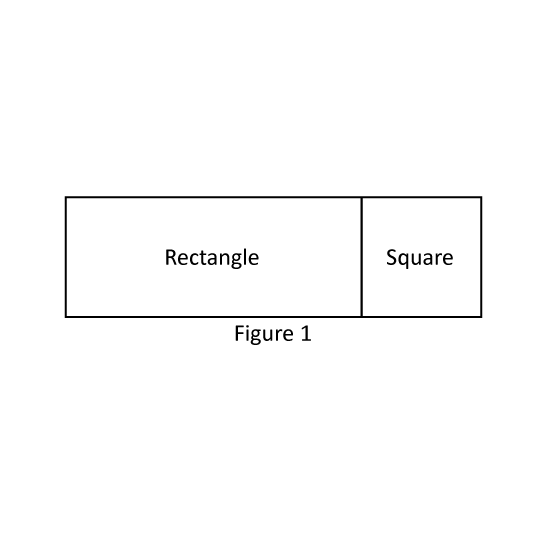Level 3 The diagrams show a pattern made up of squares.
- How many squares are there in Pattern 6?
- How many sides are there in Pattern 5?
- What is the Pattern Number for 246 sides?
Level 3 The diagrams show a pattern made up of squares.
- How many squares are there in Pattern 6?
- How many sides are there in Pattern 5?
- What is the Pattern Number for 246 sides?
Image in this question is not available.
Level 3
The figure shows a pattern formed using some ice cream sticks.
- How many ice-cream sticks are used to form 15 squares?
- How many squares can be formed using 106 ice-cream sticks?
Level 3
The figure shows a pattern formed using some ice cream sticks.
- How many ice-cream sticks are used to form 15 squares?
- How many squares can be formed using 106 ice-cream sticks?
Image in this question is not available.
Level 3
Jean had an empty container of capacity 700 cm3 and a 5-cm square base tank filled with water to a height 9 cm. She filled the container with some water until it is 34 full. She then transferred half of the water from the container into the tank. How much water was there in the tank now?
Level 3
Jean had an empty container of capacity 700 cm3 and a 5-cm square base tank filled with water to a height 9 cm. She filled the container with some water until it is 34 full. She then transferred half of the water from the container into the tank. How much water was there in the tank now?
Image in this question is not available.
Level 3
Find the sum of all the odd numbers that are less than 40.
4 m
Image in this question is not available.
Level 3 The following pattern is made up of shaded and unshaded squares.
- Find the values of (i), (ii) and (iii). Give your answers in the following format. (Eg 1, 2, 3)
- Find the number of unshaded squares for Figure 30.
- Find the number of shaded squares for Figure 30.
Level 3 The following pattern is made up of shaded and unshaded squares.
- Find the values of (i), (ii) and (iii). Give your answers in the following format. (Eg 1, 2, 3)
- Find the number of unshaded squares for Figure 30.
- Find the number of shaded squares for Figure 30.
Image in this question is not available.
Level 3
Sally had a piece of wire 8 m long. She cut 8 pieces each measuring 12 m long from the original piece. The remainder was used to form a square. Find the area of the square.
3 m
Image in this question is not available.
Level 3
The figure is not drawn to scale. A tank has a square base area of 81 m2. It was filled with water to a height of 2 m. Freda added 18 pails of water and the height of the water level rose to 13 m. Find the volume of each pail. Give your answer in m3.
Level 3
The figure is not drawn to scale. A tank has a square base area of 81 m2. It was filled with water to a height of 2 m. Freda added 18 pails of water and the height of the water level rose to 13 m. Find the volume of each pail. Give your answer in m3.
Image in this question is not available.
Level 3
The figure shows a garden in the school with two ponds beside each other. The koi pond is a square pond with an area of 64 m
2 . The area of the rectangular turtle pond is
34 of the area of the koi pond. The length of the grass patch is twice the breadth of the grass patch.
- What is the breadth of the turtle pond?
- What is length of the grass patch?
Level 3
The figure shows a garden in the school with two ponds beside each other. The koi pond is a square pond with an area of 64 m
2 . The area of the rectangular turtle pond is
34 of the area of the koi pond. The length of the grass patch is twice the breadth of the grass patch.
- What is the breadth of the turtle pond?
- What is length of the grass patch?
Image in this question is not available.
Level 3
The following is made up of identical triangles. Study the pattern carefully.
- Complete the table for Figure 4.
- A figure number in the pattern has a total of 144 triangles. What is the figure number?
Level 3
The following is made up of identical triangles. Study the pattern carefully.
- Complete the table for Figure 4.
- A figure number in the pattern has a total of 144 triangles. What is the figure number?
Image in this question is not available.
Level 3
The figure shows a rectangle in a square. The square is of side 15 cm. What is the area of the rectangle?
Level 3
The figure shows a rectangle in a square. The square is of side 15 cm. What is the area of the rectangle?
Image in this question is not available.
Level 3
James formed some figures using squares and circles as shown
- Find the number of squares in Figure 6.
- Find the total number of circles and squares in Figure 10.
- A figure in the pattern has a total of 6481 circles and squares. What is the Figure Number?
Level 3
James formed some figures using squares and circles as shown
- Find the number of squares in Figure 6.
- Find the total number of circles and squares in Figure 10.
- A figure in the pattern has a total of 6481 circles and squares. What is the Figure Number?
Image in this question is not available.
TRY FOR FREE
Level 3
Peter had a square piece of paper. He cut it along the dotted lines as shown in Figure 1 to get one small square of side 2 cm and four identical right-angled triangles. One such triangle is shown in Figure 2. Find the perimeter of the square piece of paper in Figure 1 before it was cut.
Level 3
Peter had a square piece of paper. He cut it along the dotted lines as shown in Figure 1 to get one small square of side 2 cm and four identical right-angled triangles. One such triangle is shown in Figure 2. Find the perimeter of the square piece of paper in Figure 1 before it was cut.
Image in this question is not available.
Level 2
The figure is made up of a square and a rectangle. The area of the square is 13 the area of the rectangle. Given that 12 of the square is shaded, what fraction of the whole figure is unshaded?
Level 2
The figure is made up of a square and a rectangle. The area of the square is 13 the area of the rectangle. Given that 12 of the square is shaded, what fraction of the whole figure is unshaded?
Image in this question is not available.
Level 2
The figure shows a piece of square paper with two of the corners folded. Triangle A and Triangle B are identical and Triangle XYZ is an equilateral triangle. Find the area of the shaded part.
Level 2
The figure shows a piece of square paper with two of the corners folded. Triangle A and Triangle B are identical and Triangle XYZ is an equilateral triangle. Find the area of the shaded part.
Image in this question is not available.
Level 3
PQRS is a square of area 64 cm2. X and Y are midpoints of PQ and PS respectively. Find the area of the shaded triangle.
Level 3
PQRS is a square of area 64 cm2. X and Y are midpoints of PQ and PS respectively. Find the area of the shaded triangle.
Image in this question is not available.
Level 2
Abby used a piece of wire 3.68 m long to make 4 squares as shown. What is the length of AB?
Level 2
Abby used a piece of wire 3.68 m long to make 4 squares as shown. What is the length of AB?
Image in this question is not available.
Level 2
The figure is made up of two identical rectangles and a square. Find the perimeter of the figure.
Level 2
The figure is made up of two identical rectangles and a square. Find the perimeter of the figure.
Image in this question is not available.
Level 3
In the figure, The area of the Square A is 16 cm2 and the area of Square B is 36 cm2. Find the perimeter of the figure.
Level 3
In the figure, The area of the Square A is 16 cm2 and the area of Square B is 36 cm2. Find the perimeter of the figure.
Image in this question is not available.
Level 3
In the figure, MNOP is a square and OPQ is an equilateral triangle. Find ∠a.
Level 3
In the figure, MNOP is a square and OPQ is an equilateral triangle. Find ∠a.
Image in this question is not available.
Level 3
A thin wire, 132 cm long, is bent to form Figure 1 which consists of a square and a rectangle. If the wire does not overlap and the breadth of the rectangle is one third its length, what is the perimeter of the figure?
Level 3
A thin wire, 132 cm long, is bent to form Figure 1 which consists of a square and a rectangle. If the wire does not overlap and the breadth of the rectangle is one third its length, what is the perimeter of the figure?
Image in this question is not available.
